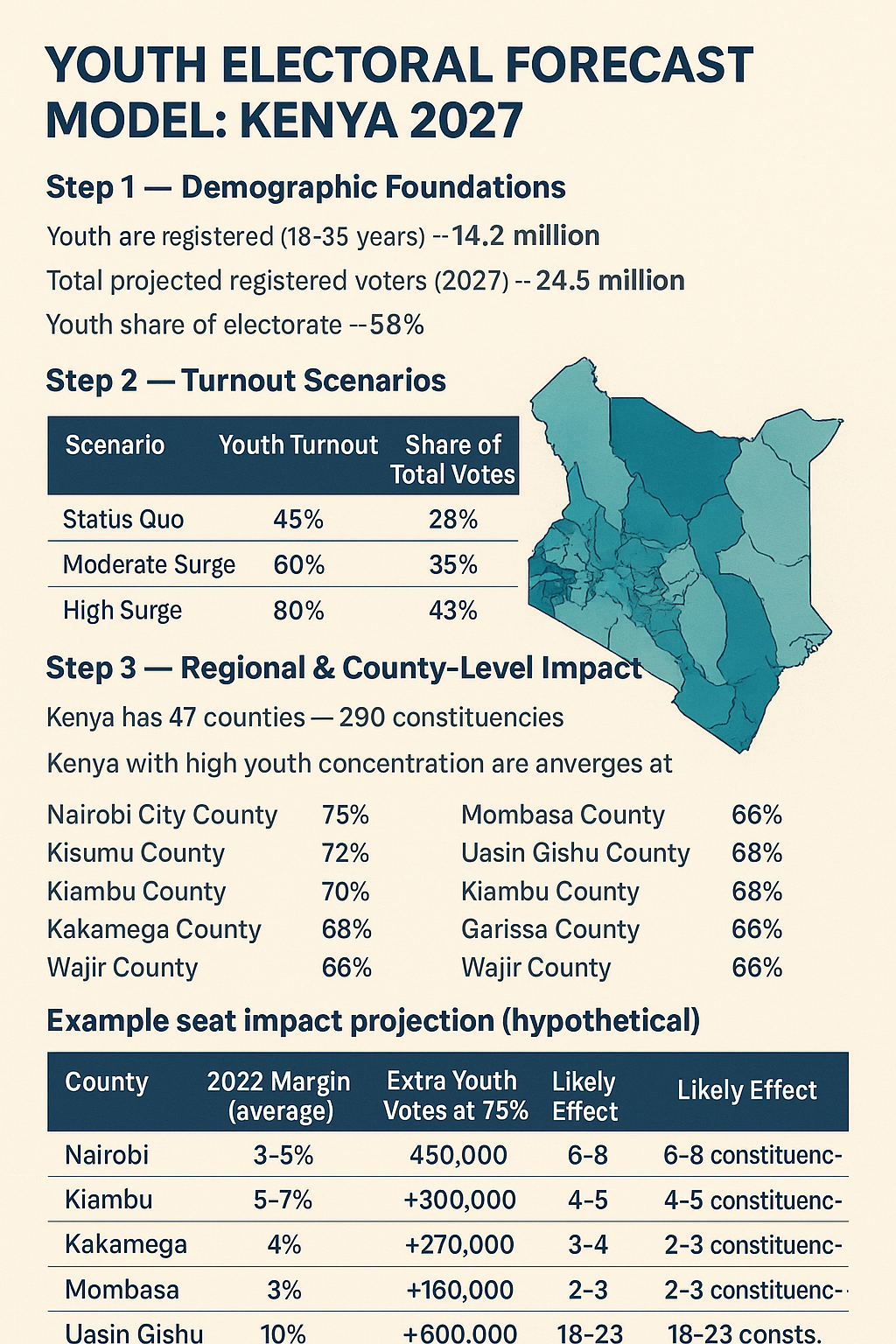
simply amazing, always for you.
As Kenya inches closer to the 2027 Kenyan general election, one question looms large: Will young voters reshape the nation’s political future? This isn’t just idle speculation. Demographic data, electoral trends, and social movements all point to a rapidly rising generation—primarily Generation Z (Gen Z) and younger Millennials—who could hold the balance of power in determining Kenya’s next government.

In the 2022 Kenyan general election, voters aged 18 to 34 already accounted for about 40% of the electorate. By 2027, that number will be even larger. Millions of young Kenyans will have reached voting age, and the Independent Electoral and Boundaries Commission (IEBC) has announced an ambitious target to register about 5.6 million new voters. Most of these will be first-time voters.
But numbers alone don’t win elections. To understand how youth could shape 2027, we must go beyond the raw statistics. This article explores the social, economic, and political forces driving youth participation, the barriers and risks that could hinder their influence, and the ways young people might transform the tone, issues, and outcomes of the next general election.
The Demographic Power of Youth in Kenya
The Youth Bulge and What It Means
Kenya is a youthful country. More than 75% of the population is under 35. This is not a passing phase but a demographic structure that has held steady for decades, creating what analysts often call a “youth bulge.” This youth bulge means millions of new voters enter the rolls every election cycle, steadily expanding the weight of the youth vote.
According to recent IEBC projections, more than 5.6 million new voters are expected to be registered by 2027, the vast majority of them young Kenyans aged 18 to 24. Combined with those who voted in 2022 as first-time voters and will still be under 30, this means youth could make up nearly half the entire electorate.
This demographic reality creates a potential political tipping point. If youth turn out in large numbers and vote in relatively cohesive ways—prioritizing shared issues rather than being splintered by ethnicity or clientelism—they could fundamentally realign Kenya’s political landscape.
Why Youth Numbers Matter
Historically, older generations have dominated Kenya’s political decisions because of higher turnout rates. Youth have often registered in large numbers but voted in smaller proportions. If this pattern changes in 2027, and youth turnout matches or exceeds older cohorts, the impact could be profound:
- Close races in swing constituencies could tip toward candidates with strong youth backing.
- National campaigns would be forced to center youth concerns rather than viewing them as secondary.
- Political parties might be compelled to recruit and elevate younger leaders.
In short, youth numbers give them latent power; turnout and coordination can convert it into actual influence.
The Emerging Priorities of Young Voters
Issue-Based Politics Over Ethnic Loyalty
One of the most striking shifts visible among young Kenyans is their declining attachment to ethnic voting blocs. While ethnic identity has long shaped voting patterns, many Gen Z Kenyans appear more willing to prioritize issues over identity. This is a crucial shift.

Surveys and interviews with youth show growing frustration with:
- Corruption and impunity
- Unemployment and underemployment
- The high cost of living
- Inequality in opportunities
- Poor service delivery and infrastructure
- Lack of transparency in governance
They are demanding solutions, not slogans. While ethnic loyalties won’t vanish overnight, this emerging mindset could disrupt the old calculus of mobilizing voters purely through tribal networks.
Economic Anxiety as a Driving Force
Kenya’s youth unemployment rate is one of the highest in the region. Even among those with degrees or diplomas, decent jobs are scarce. The informal sector absorbs many, but it offers little stability. Rising living costs—from food to transport to housing—compound these anxieties.
Economic hardship is pushing young voters to seek leaders who offer credible, detailed plans, not vague campaign promises. Youth-led protests in 2023 and 2024 over tax increases and economic mismanagement showed how willing they are to challenge authority when economic pain becomes intolerable.
This means any 2027 candidate who hopes to win youth support must treat the economy as priority number one.
Demand for Transparency and Accountability
Young voters are deeply skeptical of traditional political elites. Many grew up witnessing scandals, broken promises, and state capture by well-connected elites. They now demand clean governance, accountability, and transparency.
Social media has amplified this skepticism. Young people use platforms to fact-check politicians, expose corruption, and mobilize protests. This trend makes it harder for candidates to rely solely on controlled campaign messaging. Authenticity and integrity are now political currency among the youth.
How Young Voters Could Reshape 2027
1. Shifting Electoral Margins
In tight contests, a small shift in the youth vote could be decisive. Constituencies long seen as “safe” could become competitive if youth voters either defect from traditional party lines or simply turn out in higher numbers than before.
This means parties can no longer rely on tribal arithmetic alone. They must win the youth, or risk losing their base.
2. Redefining Campaign Strategies
Campaigns have traditionally focused on patronage networks, ethnic alliances, and large rallies. Young voters, however, are digital natives. They get information from social media, not political barazas. They respond to issues, stories, visuals, and peer-to-peer persuasion more than to party machinery.
This forces campaigns to:
- Invest heavily in digital outreach
- Create relatable, issue-based content
- Engage influencers and youth-led civic organizations
- Respond rapidly to misinformation and online debates
A failure to do so could leave candidates invisible to millions of voters who live primarily online.
3. Disrupting Ethnic Bloc Politics
Kenya’s politics has often been a contest between ethnic coalitions. But the rise of an issue-driven youth electorate could fragment these blocs. If Gen Z voters cut across ethnic lines in pursuit of common economic or governance goals, they could break the hold of ethnic kingpins.
This would be historic. It would signal a generational shift away from ethnic politics toward policy competition.
4. Elevating New Young Leaders
Already, a crop of youthful aspirants is emerging—men and women in their 20s and 30s contesting county assembly, parliamentary, and even gubernatorial seats. They present themselves as clean, energetic, innovative, and relatable compared to the old guard.
A strong youth vote could carry some of these new leaders into office, injecting fresh perspectives and shaking entrenched political hierarchies.
5. Forcing Policy Innovation
Youth priorities—job creation, cost of living, tech, climate change, education reform—will push parties to offer real policies, not just promises. Manifestos might grow more detailed, debates more substantive, and campaign rhetoric more grounded in data.
Barriers and Challenges Facing Youth Influence
Despite their potential, several hurdles could limit youth impact in 2027.
Low Voter Turnout and Registration Gaps
Youth are numerous, but many are not registered to vote. Others have IDs but don’t follow through with registration. And even those registered often fail to turn out. Reasons include:
- Lack of awareness or interest
- Apathy due to perceived corruption and futility
- Logistical obstacles (travel costs, job constraints, long queues)
Unless these challenges are tackled, millions of youth voices will remain unheard.
Fragmentation and Lack of Unity
Youth are not a monolith. Urban youth face different realities from rural youth. Young women may prioritize different issues from young men. Education levels shape political expectations. This diversity is a strength, but it also means the youth vote can scatter among many candidates, diluting its impact.
Without some degree of coordination or shared agenda, youth influence may remain latent rather than decisive.
Risk of Co-optation
Kenya’s political elite are skilled at co-opting youthful energy—offering positions, handouts, or symbolic roles to neutralize youth dissent. If youth movements are drawn into patronage systems, they may lose independence and credibility, blunting their transformative power.
Misinformation and Manipulation
The digital spaces where youth thrive are also rife with disinformation, propaganda, and algorithmic echo chambers. Politicians may exploit this to mislead or polarize youth. Without strong digital literacy, young voters could be manipulated despite their enthusiasm.
Economic Pressures
Many young people struggle with daily survival—unemployment, low pay, unstable livelihoods. On election day, they may lack transport fare to polling stations, or may prioritize work over voting. Poverty can also make them vulnerable to vote-buying, undermining issue-based choices.
What Political Parties Must Do to Win the Youth Vote
If parties and candidates want to win in 2027, they must take youth seriously—not just as campaign mobilizers, but as core decision-makers. Here’s what that requires:
1. Craft Realistic, Detailed Policy Proposals
- Jobs and entrepreneurship opportunities
- Affordable education and skills training
- Lower cost of living
- Healthcare access
- Affordable housing and transport
- Climate and environmental protection
- Digital economy development
These must be costed, time-bound, and transparent. Empty promises will no longer suffice.
2. Use Digital Campaigning Strategically
- Create strong social media presences
- Engage credible influencers and youth voices
- Use data analytics to understand youth concerns
- Counter misinformation promptly
- Offer interactive platforms where youth can ask questions and get answers
3. Make Registration Easy and Accessible
- Support nationwide voter registration drives
- Partner with youth organizations and campuses
- Provide mobile registration units in remote areas
- Pressure government agencies to fast-track issuance of IDs
4. Include Youth in Leadership
- Nominate youthful candidates
- Create meaningful youth wings with real influence
- Promote intergenerational ticket combinations (young + veteran)
- Allow young people to shape party manifestos and strategies
5. Build Trust Through Consistency
Many young Kenyans distrust politics because of broken promises. Candidates must:
- Show records of delivering results
- Admit past failures honestly
- Maintain engagement beyond campaign periods
Trust is built through consistency, not speeches.
Possible Scenarios for the 2027 Elections
Scenario A: High Youth Turnout and Issue-Driven Voting
If young Kenyans register in large numbers, turn out strongly, and vote based on issues, the 2027 elections could produce:
- Surprise wins for youthful or reformist candidates
- Major policy shifts in party manifestos
- Collapse of traditional ethnic strongholds
- Stronger parliamentary oversight and accountability culture
This would mark a generational shift in Kenyan politics.
Scenario B: Low Turnout or Fragmented Youth Vote
If registration remains low, turnout is weak, or youth scatter across many candidates, then the status quo will likely prevail. Established parties will dominate using traditional ethnic and patronage structures.
This would squander the demographic dividend and prolong youth marginalization.
Scenario C: Co-optation of Youth Energy
If youth movements are absorbed into elite patronage networks—via token positions, handouts, or symbolic roles—their energy may be neutralized. Rhetoric may change, but power structures will remain intact. Youth will have influence in appearance but not in substance.
Beyond 2027 — Building Sustainable Youth Power
To ensure their influence endures beyond one election cycle, young Kenyans must focus not only on voting but also on building long-term political muscle.
Key steps include:
- Civic education and political literacy: Understanding policies, budgets, and laws to hold leaders accountable
- Forming youth-led political movements and parties: Not just joining old structures, but creating new ones rooted in integrity and service
- Running for office at all levels: From student councils to county assemblies, building experience and networks early
- Maintaining activism between elections: Monitoring government actions, using courts, audits, and protests to enforce accountability
- Creating pan-ethnic youth coalitions: So that ethnic divides cannot be exploited to split their vote
The 2027 Kenyan general election could become a turning point in Kenya’s political history—if young voters rise to the moment.
Their numbers are unprecedented, their frustrations are deep, and their appetite for change is real. But transforming that potential into actual political power will require mass registration, high turnout, unity around issues, and resistance to co-optation.
If they succeed, youth could disrupt ethnic politics, dethrone complacent elites, and redefine Kenya’s future on their own terms. If they fail, the status quo will persist, and another five years will pass while their generation waits on the sidelines.
The choice—and the power—are in their hands.
SUGGESTED READS
- RutonomicsAt3 — The True State of William Ruto’s Economic Legacy After 3 Years
- The Untold Story of Africa’s First Scholars: The Legacy of Timbuktu and the Rise of Literacy on the Continent
- Understanding the 2022 Kenyan Elections: Have We Learned from the Past?
- Kibaki vs. Raila: A Timeline of Political Rivalry and National Impact
- The Role of the International Criminal Court in African Conflicts

Support Our Website!
We appreciate your visit and hope you find our content valuable. If you’d like to support us further, please consider contributing through the TILL NUMBER: 9549825. Your support helps us keep delivering great content!
If you’d like to support Nabado from outside Kenya, we invite you to send your contributions through trusted third-party services such as Remitly, western union, SendWave, or WorldRemit. These platforms are reliable and convenient for international money transfers.
Please use the following details when sending your support:
Phone Number: +254701838999
Recipient Name: Peterson Getuma Okemwa
We sincerely appreciate your generosity and support. Thank you for being part of this journey!
